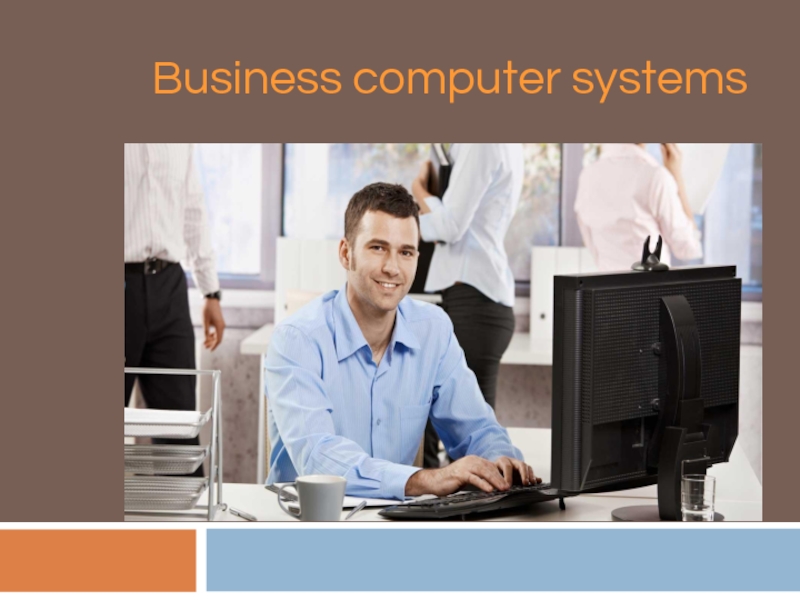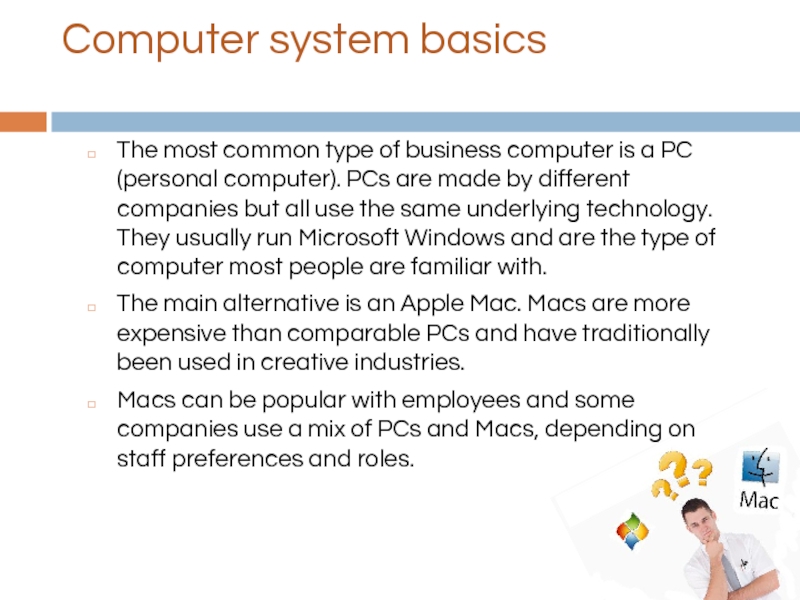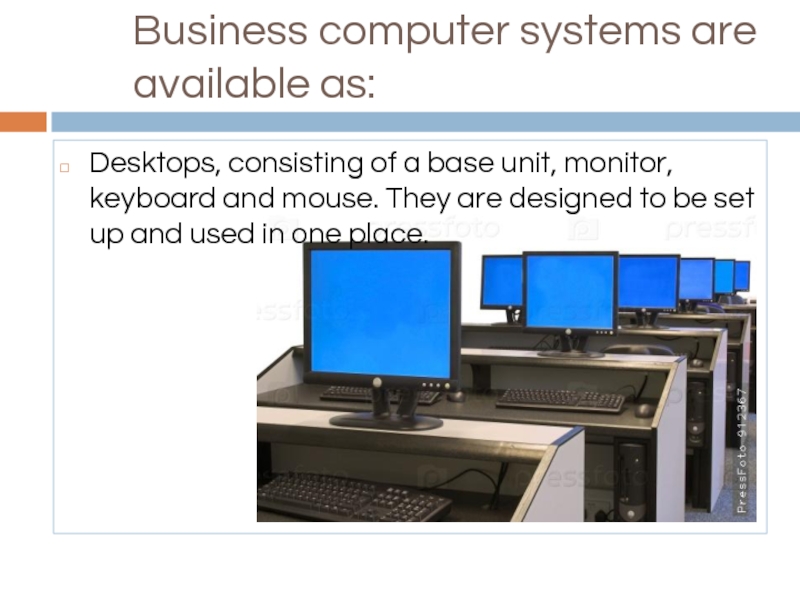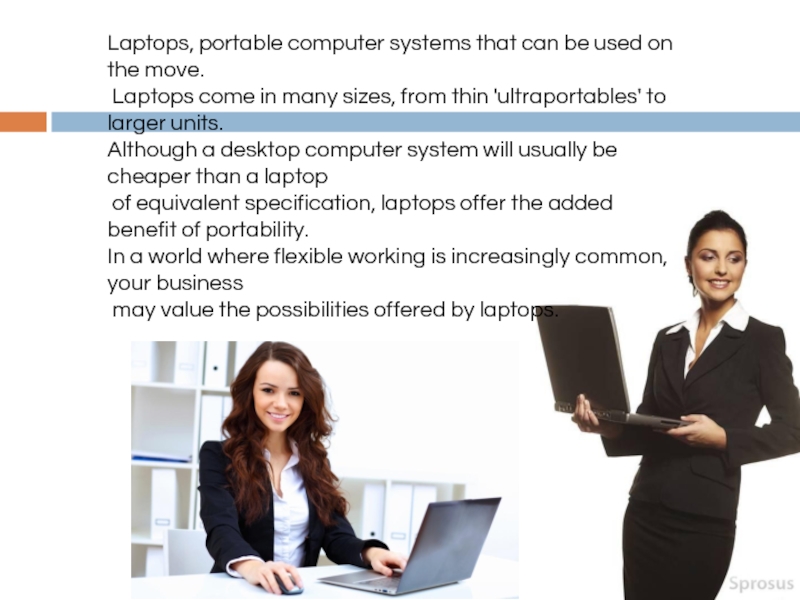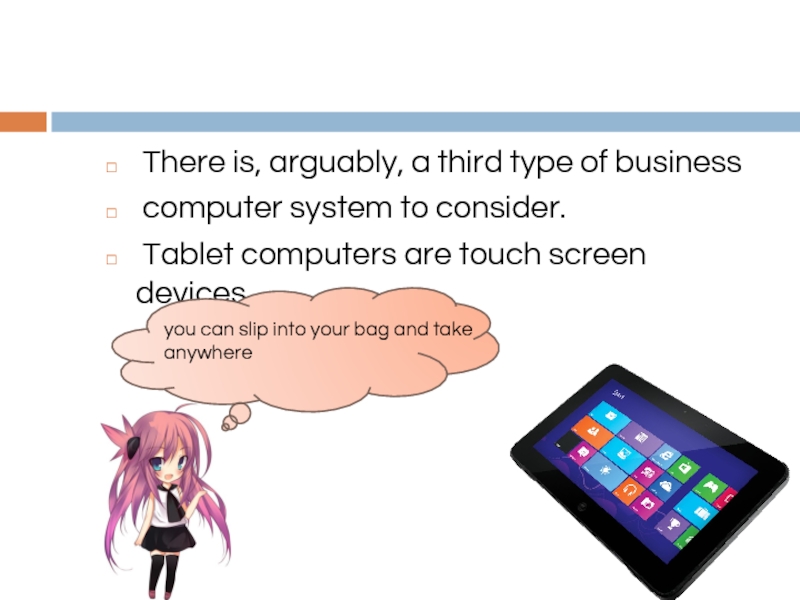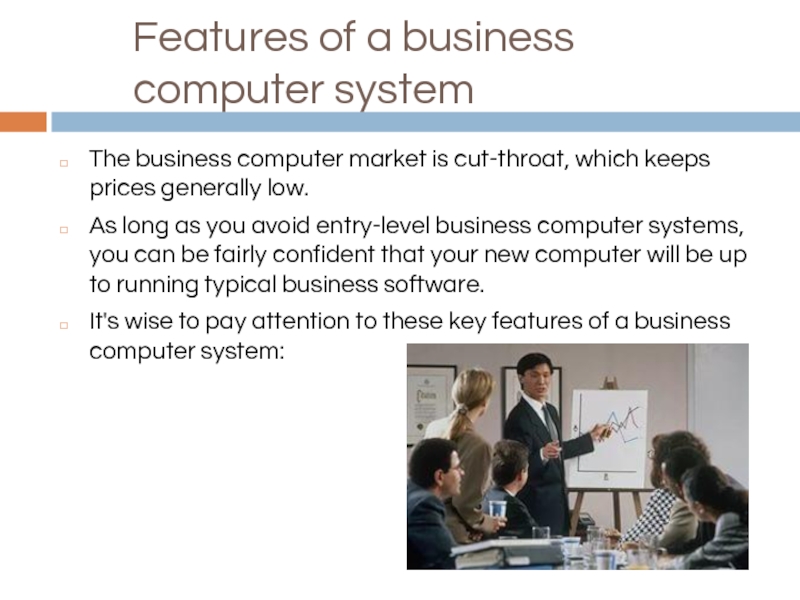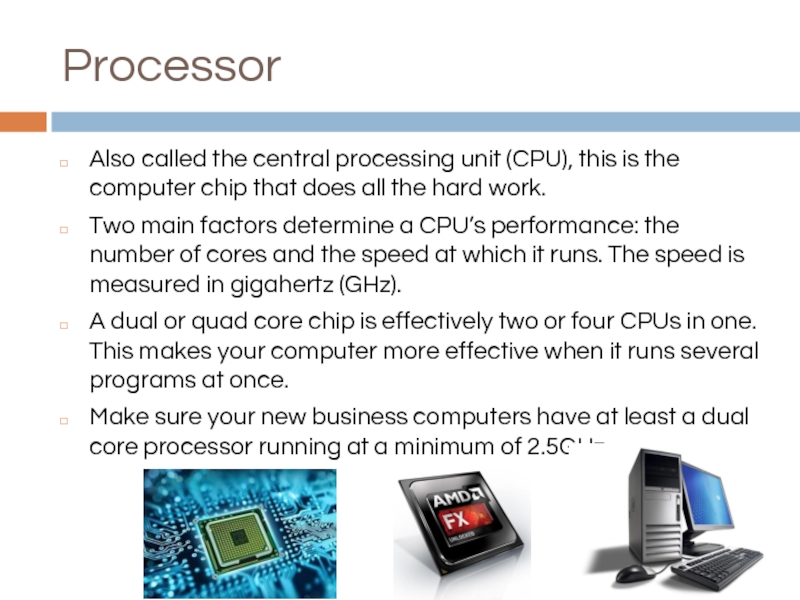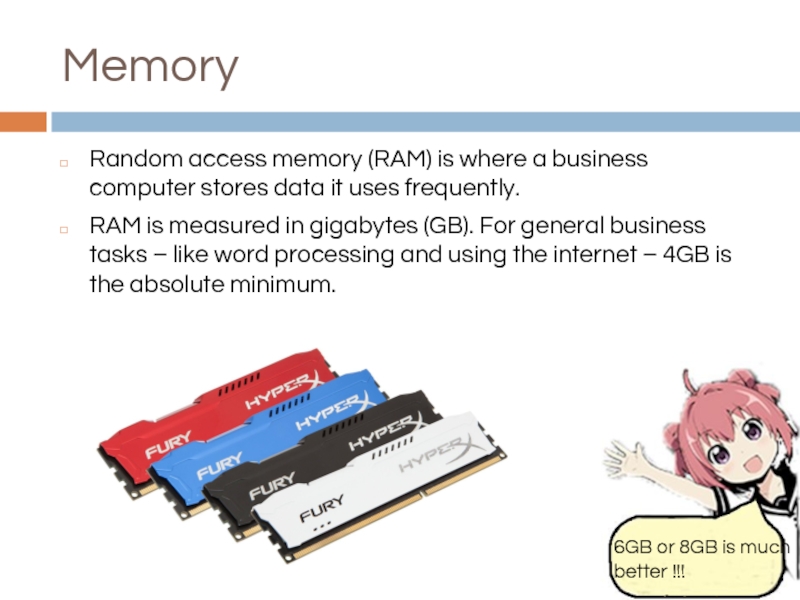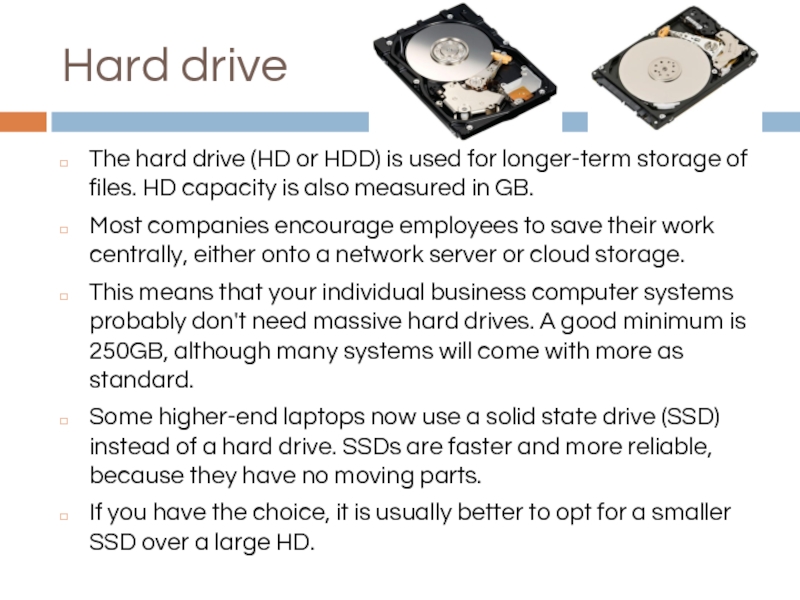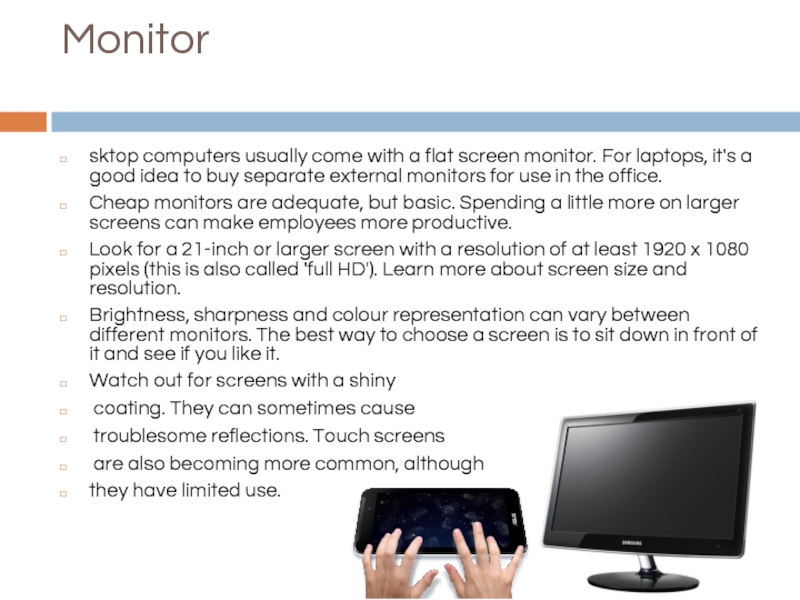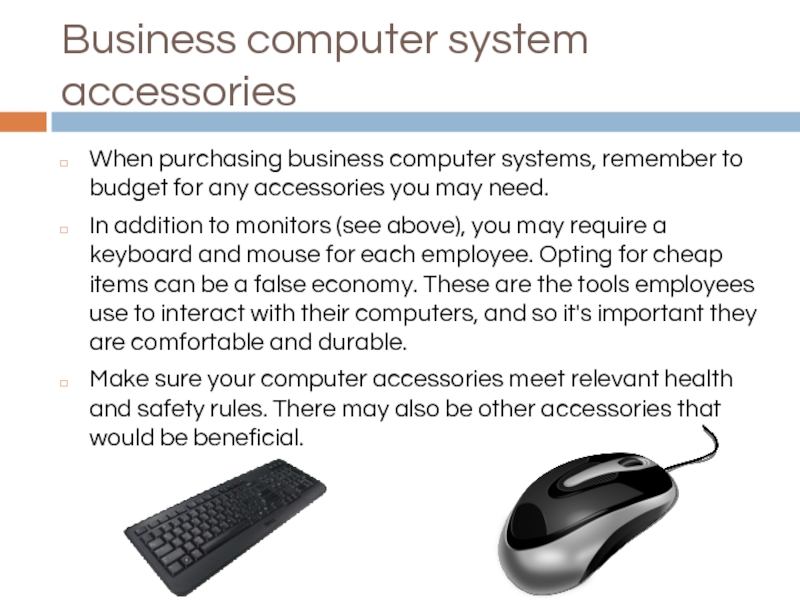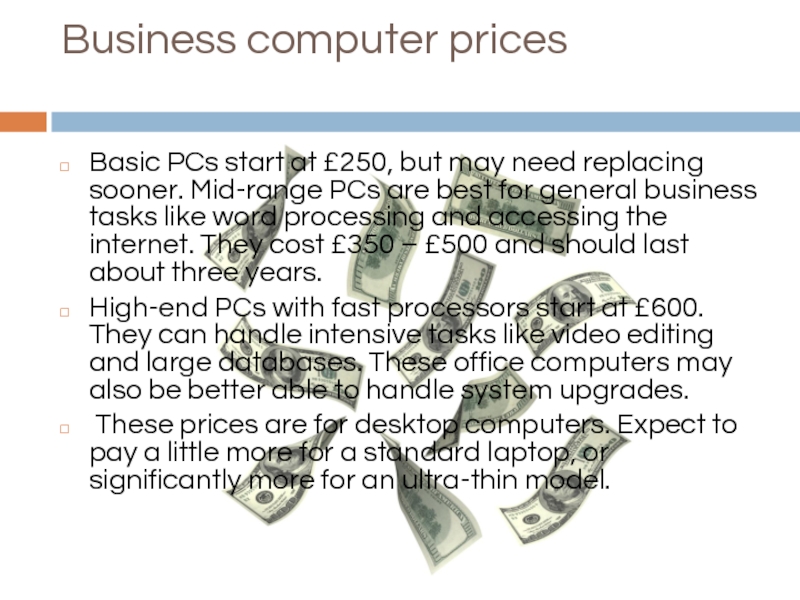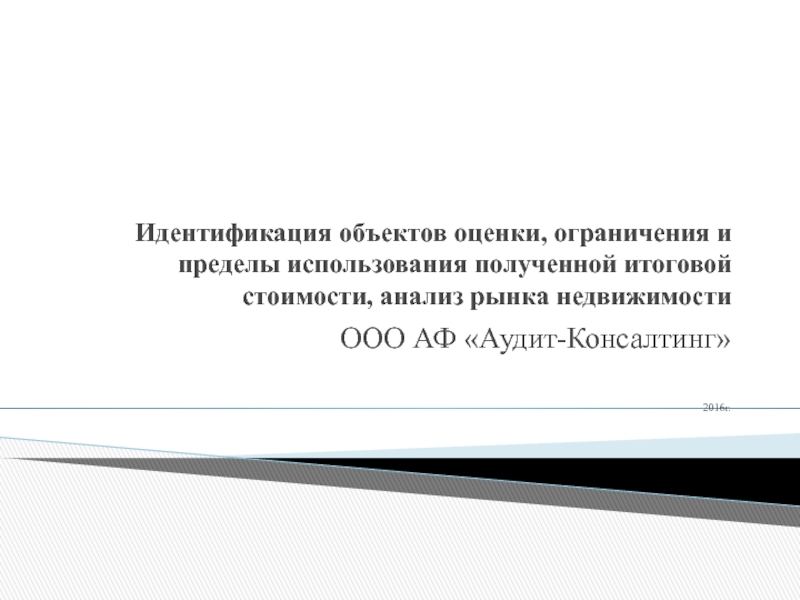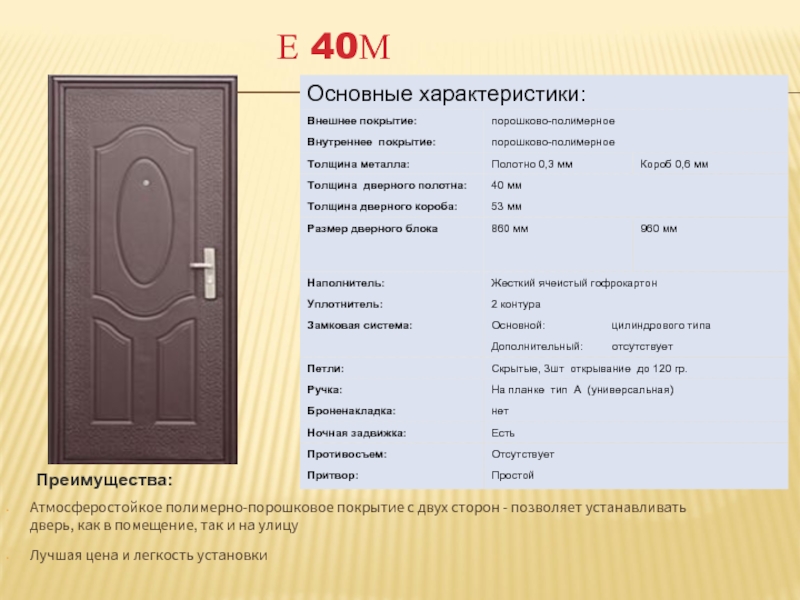- Главная
- Разное
- Дизайн
- Бизнес и предпринимательство
- Аналитика
- Образование
- Развлечения
- Красота и здоровье
- Финансы
- Государство
- Путешествия
- Спорт
- Недвижимость
- Армия
- Графика
- Культурология
- Еда и кулинария
- Лингвистика
- Английский язык
- Астрономия
- Алгебра
- Биология
- География
- Детские презентации
- Информатика
- История
- Литература
- Маркетинг
- Математика
- Медицина
- Менеджмент
- Музыка
- МХК
- Немецкий язык
- ОБЖ
- Обществознание
- Окружающий мир
- Педагогика
- Русский язык
- Технология
- Физика
- Философия
- Химия
- Шаблоны, картинки для презентаций
- Экология
- Экономика
- Юриспруденция
Business computer systems презентация
Содержание
- 1. Business computer systems
- 2. Computer system basics The most common
- 3. Business computer systems are available as:
- 4. Laptops, portable computer systems that can be
- 5. There is, arguably, a third type of
- 6. Features of a business computer system
- 7. Processor Also called the central processing unit
- 8. Memory Random access memory (RAM) is where
- 9. Hard drive The hard drive (HD or
- 10. Monitor sktop computers usually come with
- 11. Business computer system accessories When purchasing business
- 12. Business computer prices Basic PCs start
- 13. thank for watching Created by: Ks-12 Ivanov Dmitriy Alexandr Korneev
Слайд 2Computer system basics
The most common type of business computer is a
PC (personal computer). PCs are made by different companies but all use the same underlying technology. They usually run Microsoft Windows and are the type of computer most people are familiar with.
The main alternative is an Apple Mac. Macs are more expensive than comparable PCs and have traditionally been used in creative industries.
Macs can be popular with employees and some companies use a mix of PCs and Macs, depending on staff preferences and roles.
The main alternative is an Apple Mac. Macs are more expensive than comparable PCs and have traditionally been used in creative industries.
Macs can be popular with employees and some companies use a mix of PCs and Macs, depending on staff preferences and roles.
Слайд 3Business computer systems are available as:
Desktops, consisting of a base unit,
monitor, keyboard and mouse. They are designed to be set up and used in one place.
Слайд 4Laptops, portable computer systems that can be used on the move.
Laptops come in many sizes, from thin 'ultraportables' to larger units.
Although a desktop computer system will usually be cheaper than a laptop
of equivalent specification, laptops offer the added benefit of portability.
In a world where flexible working is increasingly common, your business
may value the possibilities offered by laptops.
Although a desktop computer system will usually be cheaper than a laptop
of equivalent specification, laptops offer the added benefit of portability.
In a world where flexible working is increasingly common, your business
may value the possibilities offered by laptops.
Слайд 5 There is, arguably, a third type of business
computer system to
consider.
Tablet computers are touch screen devices
Tablet computers are touch screen devices
you can slip into your bag and take anywhere
Слайд 6Features of a business computer system
The business computer market is cut-throat,
which keeps prices generally low.
As long as you avoid entry-level business computer systems, you can be fairly confident that your new computer will be up to running typical business software.
It's wise to pay attention to these key features of a business computer system:
As long as you avoid entry-level business computer systems, you can be fairly confident that your new computer will be up to running typical business software.
It's wise to pay attention to these key features of a business computer system:
Слайд 7Processor
Also called the central processing unit (CPU), this is the computer
chip that does all the hard work.
Two main factors determine a CPU’s performance: the number of cores and the speed at which it runs. The speed is measured in gigahertz (GHz).
A dual or quad core chip is effectively two or four CPUs in one. This makes your computer more effective when it runs several programs at once.
Make sure your new business computers have at least a dual core processor running at a minimum of 2.5GHz.
Two main factors determine a CPU’s performance: the number of cores and the speed at which it runs. The speed is measured in gigahertz (GHz).
A dual or quad core chip is effectively two or four CPUs in one. This makes your computer more effective when it runs several programs at once.
Make sure your new business computers have at least a dual core processor running at a minimum of 2.5GHz.
Слайд 8Memory
Random access memory (RAM) is where a business computer stores data
it uses frequently.
RAM is measured in gigabytes (GB). For general business tasks – like word processing and using the internet – 4GB is the absolute minimum.
RAM is measured in gigabytes (GB). For general business tasks – like word processing and using the internet – 4GB is the absolute minimum.
6GB or 8GB is much better !!!
Слайд 9Hard drive
The hard drive (HD or HDD) is used for longer-term
storage of files. HD capacity is also measured in GB.
Most companies encourage employees to save their work centrally, either onto a network server or cloud storage.
This means that your individual business computer systems probably don't need massive hard drives. A good minimum is 250GB, although many systems will come with more as standard.
Some higher-end laptops now use a solid state drive (SSD) instead of a hard drive. SSDs are faster and more reliable, because they have no moving parts.
If you have the choice, it is usually better to opt for a smaller SSD over a large HD.
Most companies encourage employees to save their work centrally, either onto a network server or cloud storage.
This means that your individual business computer systems probably don't need massive hard drives. A good minimum is 250GB, although many systems will come with more as standard.
Some higher-end laptops now use a solid state drive (SSD) instead of a hard drive. SSDs are faster and more reliable, because they have no moving parts.
If you have the choice, it is usually better to opt for a smaller SSD over a large HD.
Слайд 10Monitor
sktop computers usually come with a flat screen monitor. For laptops,
it's a good idea to buy separate external monitors for use in the office.
Cheap monitors are adequate, but basic. Spending a little more on larger screens can make employees more productive.
Look for a 21-inch or larger screen with a resolution of at least 1920 x 1080 pixels (this is also called 'full HD'). Learn more about screen size and resolution.
Brightness, sharpness and colour representation can vary between different monitors. The best way to choose a screen is to sit down in front of it and see if you like it.
Watch out for screens with a shiny
coating. They can sometimes cause
troublesome reflections. Touch screens
are also becoming more common, although
they have limited use.
Cheap monitors are adequate, but basic. Spending a little more on larger screens can make employees more productive.
Look for a 21-inch or larger screen with a resolution of at least 1920 x 1080 pixels (this is also called 'full HD'). Learn more about screen size and resolution.
Brightness, sharpness and colour representation can vary between different monitors. The best way to choose a screen is to sit down in front of it and see if you like it.
Watch out for screens with a shiny
coating. They can sometimes cause
troublesome reflections. Touch screens
are also becoming more common, although
they have limited use.
Слайд 11Business computer system accessories
When purchasing business computer systems, remember to budget
for any accessories you may need.
In addition to monitors (see above), you may require a keyboard and mouse for each employee. Opting for cheap items can be a false economy. These are the tools employees use to interact with their computers, and so it's important they are comfortable and durable.
Make sure your computer accessories meet relevant health and safety rules. There may also be other accessories that would be beneficial.
In addition to monitors (see above), you may require a keyboard and mouse for each employee. Opting for cheap items can be a false economy. These are the tools employees use to interact with their computers, and so it's important they are comfortable and durable.
Make sure your computer accessories meet relevant health and safety rules. There may also be other accessories that would be beneficial.
Слайд 12Business computer prices
Basic PCs start at £250, but may need replacing
sooner. Mid-range PCs are best for general business tasks like word processing and accessing the internet. They cost £350 – £500 and should last about three years.
High-end PCs with fast processors start at £600. They can handle intensive tasks like video editing and large databases. These office computers may also be better able to handle system upgrades.
These prices are for desktop computers. Expect to pay a little more for a standard laptop, or significantly more for an ultra-thin model.
High-end PCs with fast processors start at £600. They can handle intensive tasks like video editing and large databases. These office computers may also be better able to handle system upgrades.
These prices are for desktop computers. Expect to pay a little more for a standard laptop, or significantly more for an ultra-thin model.
